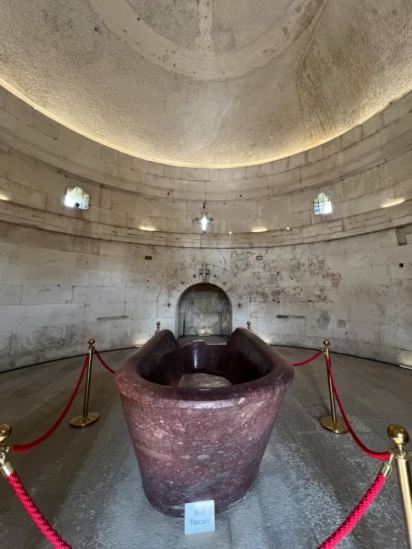The tomb of Ostrogoth King Theodoric in Ravenna is a unique construction in a town famous for its early Christian monuments and Byzantine mosaics.

The Mausoleum of Theodoric is one of eight sites in Ravenna inscribed on the UNESCO World Cultural Heritage list. In contrast to the other early Christian monuments, which are rightly famous for Byzantine mosaics, the Mausoleum of Theodoric is important mostly as being the only surviving tomb from a “barbarian” king from the late-Roman, pre-Middle Ages period. The inside of the mausoleum is empty — many visitors may be satisfied with a free peek over the fence.
Mausoleum of Theodoric the Great in Ravenna
Theodoric the Great was an Ostrogothic king who ruled Italy from AD 493 to 526. Considered a barbarian – as the Ostrogoths originated from outside the borders of the Roman Empire – the rule of Theodoric and the monumental buildings he erected in Ravenna exemplify why the term “barbarian” can be confusing when used as a modern term for a savage or uncivilized person.
Theodoric himself almost certainly ordered the construction of the tomb in a Gothic graveyard outside the Ravenna city walls. Thus, today it is still a short walk out of the town center (and over the railway line). He was entombed here after his death in AD 526, but his body was removed in AD 561 after Justinian condemned Arianism. (See The Arian Baptistery in Ravenna for more on Theodoric and Arians.)
The mausoleum subsequently became an oratory and also served as a lighthouse. Silting caused by the nearby river saw the mausoleum mostly submerged until the nineteenth century.
In contrast to other monuments in Ravenna from this period, the Mausoleum of Theodoric was built from carved stone (and not brick or large stone blocks). The stones were imported from Istria, including the solid circular stone disk that forms the roof of the building. This roof stone is 11 m in diameter and around a meter thick. It remains a mystery how this 230-ton stone was transported from Istria or lifted onto the top of the building.
Empty Interior
The two-story mausoleum has a diameter of around 4.4 m. The lower floor is ten-sided and has several spaces for tombs but is now completely empty.
The second floor is reached via a modern external staircase. This room is also bare except for a simple bathtub-like structure of porphyry stone. It was long described as the grave of Theodoric but considerable doubt exists if this was ever used for that purpose. Theodoric almost certainly had a more elaborate tomb of marble.
See Mausoleum des Theoderich for a very detailed description in German of the monument.
Visiting the Mausoleum of Theodoric in Ravenna

The Mausoleum of Theodoric is slightly outside the town center of Ravenna but still within easy walking distance – cross the railway line to a large park. (Parking is available right in front of the monument.)
Tickets (€5) are sold in a small building next to the entrance. You may get the impression the personnel feel slightly embarrassed to be charging so much. Although there are many information boards with explanations on Theodoric and the mausoleum, there is very little to see here. Many visitors may be content with the free view over the fence (from the exit gates rather than at the entrance).
Better value is a combination ticket (€10) with the Museo Nazionale di Ravenna and the Basilica di Sant’Apollinare in Classe outside Ravenna, or the first Sunday of the month when admission is free.
The Mausoleum of Theodoric certainly is of historical and artistic importance, but if pressed for time, it probably should have the lowest priority when seeing the UNESCO Cultural Heritage Sites in Ravenna.
- See Visiting the UNESCO-Listed Sites in Ravenna for more details on opening hours and admission tickets.
NEXT: Visit the Basilica of Sant’Apollinare in Classe
More Articles on Ravenna, Italy

Time-slot reservations are currently essential to see the Mausoleum of Galla Placida and the Neonian Baptistry in Ravenna. This is easiest done when buying the tickets online.
- Top Sights to See in Ravenna
- UNESCO-Listed Sites in Ravenna
- Visiting UNESCO-Listed Sites in Ravenna – Opening Hours and Tickets
- Neonian Baptistery & Archbishop’s Chapel
- Arian Baptistery
- Basilica of Sant’Apollinare Nuovo
- Basilica of San Vitale
- Mausoleum of Galla Placidia
- Mausoleum of Theodoric
- Basilica of Sant’Apollinare in Classe
- National Museum of Ravenna
- Transportation to Ravenna. Book luggage storage online for stopovers or check cheap hotel prices.
Book Guided tours of Ravenna — tours are generally three hours. For tours not including admission fees, around €12 per person must be added. Small groups and families may find better value in private tours.



